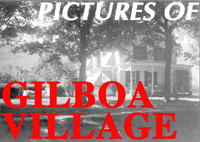



Gilboa Historical Society Newsletter
AUDIO INTERVIEWS
 |  |  |  | ||||
| Newsletter Back Issues |
By clicking on the links below, you can hear or download audio (.mov or mp4) files of interviews conducted for the Newsletter
Franklin Clapper sat down with us and talked for better than 2 hours about the Mackey area where he grew up — the people, the roads, and the farms and livelihoods. This talk broke down into these geographic areas: 1. Mackey and Guinea North ; 2. Mace Road East ; 3. Harrington Road West ; 4. Maybie/Flat Creek; and 5. Flat Creek to Five Points.
In 1942, the goal of the Soil Conservation Service of the US Department of Agriculture was to help our county's farmers attain maximum sustainable agricultural productivity to aid the war effort. This Federal Program was to be adopted by local county services to avoid the appearance of Big Brother in agricultural communities.
In New York State, Schoharie was the first county to ask for the Soil Conservation Service assistance, and Cora Utter was sent to Schoharie's fledgling Soil and Water Conservation District (SWCD). Now, on the 70th anniversary of this pioneer program, Brenda Weaver
discusses those early days
with Cora, and covers the County Board of Supervisors who initiated this successful test, the early SWCD personnel who carried the word thoughout the area, area cooperators (the progressive farmers who adopted this new program to the benefit of their own farms and the county), and the techniques that so improved agriculture in the mid-twentieth century.
The dedication of the Juried Memorial Barn and the opening of the Gilboa Museum's 2010 season was held on a georgeous Sunday, July 11, with a standing-room only crown. Click here to download the brochure from this dedication, and click on these names to hear the addresses by Kristen Wyckoff , Nick Juried , Dottie Pickett , and Kristen Wyckoff/Connie Ruehle of the Gilboa Historical Society awarding certificates, ribbons, and checks to the winning artists of the Gilboa-Conesville Central School.
Four local women shared their experiences of one-room schoolhouses — Loretta Lounsbury (Hauver School), Betty Matalavage (Shew Hollow School), Thelma Serrie (Guinea School), and Gail Shaffer (Upper School in Blenheim) — discuss various aspects of their experiences in regard to the physical description of buildings, furniture, furnishings, and class size; subjects taught and the methods used; classroom management, rewards and punishments; and games, lunch, and snacks. 1 hour 10 minutes.
Stewart Mace and Shirley Brown Kutzscher, recorded on March 25, 2009 on farming in the late 1930s. Topics range from an overview of life on the farm and the gender roles of boys and girls ( tape 1 , 7:40 minutes); the types and feeding of horses and cows on the farm ( tape 2 , 9:03 minutes); field management, rotation of crops, and cash crops of the area ( tape 3 , 7:11 minutes); other animals of the farm, ducks, chicken, sheep, and goats ( tape 4 , 5:34 minutes); farm buildings, equipment maintenance, logging and woodlot management, leases, Federal City (the area east of Broome Center), and the future of farming ( tape 5 , 5:34 minutes).
The Newsletter is published by the first of each March, June, and September and presents local history of the Western Catskills in the State of New York.
It is automatically mailed to members of the Gilboa Historical Society and on request to residents and property owners in the towns of Gilboa and Conesville. We would love to have you join our society and receive the physical Newsletter in this way — please click here for a membership application.
An electronic subscription to the Newsletter is free (please send your email address); and electronic downloads of our materials on this web site is free provided it is for non-commercial use and for your personal enjoyment only.
Copyright © 2008
gilboahome.com
December 3, 2011